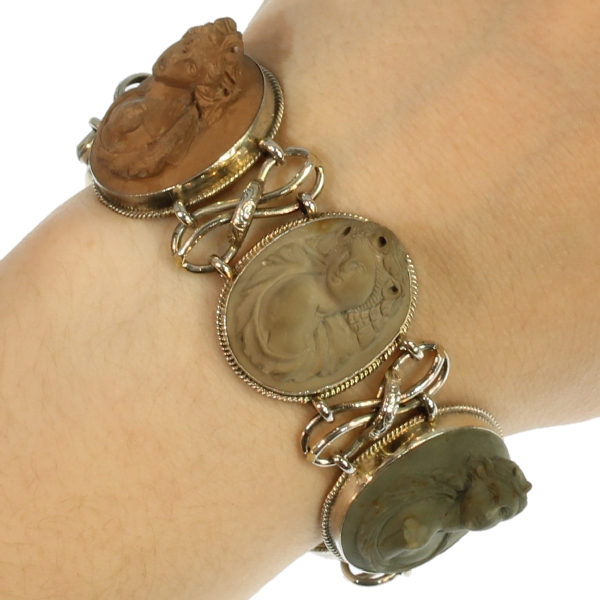We offer layaway, spread payments on the piece of your dreams. Ask us for details. Free insured shipping on all orders !!!
French antique lava stone cameo silver bracelet
Antique jewelry object group: bracelet
Condition: good condition (some traces of wear)
- (more info on our condition scale)
Country of origin:
France
Style:
Victorian - Victorian decorative arts refers to the style of decorative arts during the Victorian era. The Victorian era is known for its eclectic revival and interpretation of historic styles and the introduction of cross-cultural influences from the
middle east and Asia in furniture, fittings, and Interior decoration. Victorian design is widely viewed as having indulged in a regrettable excess of ornament. The Arts and Crafts movement, the aesthetic movement, Anglo-Japanese style, and Art Nouveau
style have their beginnings in the late Victorian era.
- See also: Victorian
or more info on styles
Style specifics:
The Grand Victorian Period - Experts divide the reign of Queen Victoria, also called The Victorian era (1837 - 1901) into three periods of about twenty years each; The Romantic Victorian Period (1837 - 1860), The Grand Victorian Period (1860 - 1880),
and the Late or Aesthetic Victorian Period (1880 - 1901).
We consider this to be of the Grand Victorian Period.
This second Victorian period is famous for its ostentatious pieces set with pearls and diamonds (from South Africa). From ca. 1850 wealthy English had reported about jewelry from India and Japan, which heavily inspired the jewelers of this period. This
period also corresponds with the death of Queen Victoria's husband King Albert making mourning jewelry (set with heavy dark stones) the type of jewelry specific for this period.
Period: ca. 1870
- (events and facts in 1870)
Source of inspiration: Pompeii
Material: Silver with traces of gilding
- (more info on precious metals)
Technique:
Cameo is a method of carving, or an item of jewellery or vessel made in this manner. It features a raised (positive) relief image. There are three main materials for Cameo carving; Shells or Agate (called a Hardstone cameo), and glass. Cameos can be
produced by setting a carved relief, such as a portrait, onto a background of a contrasting colour. This is called an assembled cameo. Alternately, a cameo can be carved directly out of a material with integral layers or banding, such as (banded) agate
or layered glass, where different layers have different colours. Sometimes dyes are used to enhance these colours. Cameos are often worn as jewellery. Stone cameos of great artistry were made in Greece dating back as far as the 6th century BC. They were
very popular in Ancient Rome, and one of the most famous stone cameos from this period is the Gemma Claudia made for the Emperor Claudius. The technique has since enjoyed periodic revivals, notably in the early Renaissance, and again in the 17th, 18th
and 19th centuries.
Extra information:
Jewelry like this was inspired by the excavations of Pompeii and typical for the mid and late 19th Century.
The city of Pompeii was an ancient Roman town-city near modern Naples in the Italian region of Campania, in the territory of the comune of Pompei. Pompeii, along with Herculaneum and many villas in the surrounding area, was mostly destroyed and buried
under 4 to 6 m (13 to 20 ft) of ash and pumice in the eruption of Mount Vesuvius in 79 AD. The site was lost for about 1,500 years until its initial rediscovery in 1599 and broader rediscovery almost 150 years later by Spanish engineer Rocque Joaquin de
Alcubierre in 1748. Pompeii has been a tourist destination for over 250 years.(From: Wikipedia)
Carlo di Borbone began excavations in 1748, as a way of increasing the fame and prestige of his nascent Kingdom of the Two Sicilies. Digging proceeded sporadically, here and there at random; it was several years before the site was identified as Pompeii,
and even then there was no systematic town plan. The first features to be exposed were part of the necropolis outside Porta Ercolano, the temple of Isis and part of the theatres quarter. During the French occupation of Naples, 1806-1815, there was much
more activity on the site, but with the restoration of the Bourbons excavations gradually slowed down again. Work was concentrated on the area of the amphitheatre and the Forum, as well as around Porta Ercolano and the theatres.
The discovery of the House of the Faun containing the large mosaic depicting Alexander the Great in battle caught the imagination of people all over Europe ollowing the Unification of Italy in 1861, the appointment of Giuseppe Fiorelli as director marked
a turning-point in the excavations. From now on the site was explored systematically, linking up the various features that had been exposed, detailed records were kept, and the wall paintings were left in situ, rather than being detached and taken to the
museum in Naples. (From: History of the excavation of Pompeii)
Precious stones:
cameo
lava jewelry
- (more info on precious stones)
Hallmarks: The French control mark for 800 silver representing a boar's head that was in use in France from about 1838.
- (more info on hallmarks)
Dimensions: length 18,50 cm (7,28 inch)
Weight: 49,60 gram (31,89 dwt)
Reference Nº: 14207-0124
Copyright photography: Adin, fine antique jewelry
jewelry with human face,
silver jewelry or jewelry with silver,
cameo jewelry,
latest acquisitions,
antique jewelry,
estate jewelry,
vintage jewelry or
modern jewelry
Jewelry with birthstones (or month stones) for:
January -
February -
March -
April -
May -
June -
July
August -
September -
October -
November or
December.
Additional information:
jewelry glossary -
wall of fame -
visit us in Antwerp -
subscribe to our mailinglist.
What is antique jewelry? -
What is estate jewelry? -
What is vintage jewelry?




